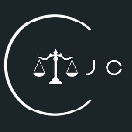CJC-F, CJC-F Events
Forensic Science Conference 2018: An Insights into Forensics
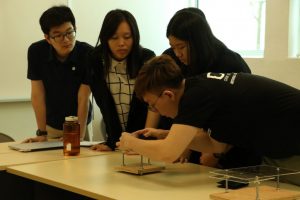
In Singapore, forensic science has played a significant role in fighting crime and resolving criminal cases. From PP v Tan Chor Jin to the more recent case in PP v Govindasamy s/o Nallaiah, forensic evidence has become more pivotal than ever. But how many of us know much about evidence? How can one learn more?
Last Saturday, on the 17 of March, students from various junior colleges, polytechnics and universities came down to NUS Law for a day of law, investigation and intrigue. Students got to learn more not just about criminal law, but also the intricacies of Evidence as well as police investigations from practice, from various professors, prosecutors and state counsel.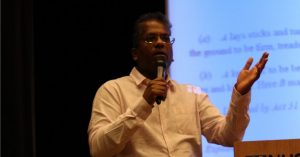
The event kicked off with a quick talk by our very own Professor Kumarlingam, who gave a lecture titled Introduction to Murder as defined in the Penal Code. This was a lecture on the difficulties of Section 300 of the Penal Code in practice. Prof Kumar posed the audience a number of tricky hypothetical scenarios, one of them being a tale of 4 men on a train, each of whom stabbed a victim at a different time. He then used it to illustrate the difficulty of concurrence, positing to the crowd, ‘what if he died by the 3rd stab? Is the 4th man a murderer?’ He then ended off his short lecture with a story of how a prank actually led to the arrest of a fugitive who was wanted for years, via urine sample.
After Prof Kumar finished his lecture, we then got to listen to a mini-lecture series. These lectures helped acquaint the attendees to the finer points of criminal investigation, such as the pre-trial and trial process. In order, we had Introduction to Evidence Law by Mr. Benny Tan, Introduction to Forensic Science by A/P Stella Tan, Pre-Trial and Trial Process – Forming the Charge by Dy SSC Zhuo Wenzhao, and Preparing the Defence & Other Considerations by Mr. Kalidass Murugaiyan.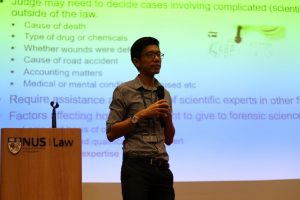
Mr. Tan started us off with a lecture on Evidence Law, diving straight into the basics. While the trial is the process by which one finds out what happened. In the past, where we could not find the true facts, there was trial by combat or even trial by ordeal. But the trial of modern day is far more sophisticated. Mr. Tan then went through some basic concepts in Evidence Law, such as the admissibility of evidence. Mr. Tan also went through classic cases such as the case of Sunny Ang, a locus classicus on circumstantial evidence, before ending with a quick sojourn on factors the judge takes into consideration when considering the evidence.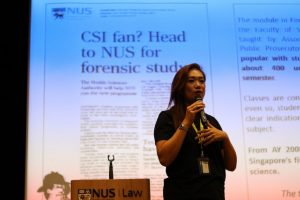
A/P Stella Tan, as one of the founding members of the NUS Forensic Science Minor, practically gushed about the importance of Forensic Science. She introduced the hall to various individuals, such as Dr. Henry C. Lee, one of the world’s foremost forensic experts as well as her mentor. A/P Stella talked about the central dogma of forensic science as a ‘muted witness’, before showing the hall a short clip, depicting a reenactment of a forensic investigation regarding a supposed suicide.
The clip was very engaging, with the audience watching on the edge of their seat. As it turned out, the supposed suicide was but an elaborate cover-up created by a dastardly thief. A thief who, under the guise of needing to make a call, entered the victim’s apartment and held a knife to her neck over just 20 dollars. Not only did the thief knock her out, forensic evidence also proved that she had been strangled.
After the clip, A/P Stella then went through various cases she handled as a DPP. Amongst these cases, they included PP v Barokah, a case of murder by maid; an unnamed case of human trafficking for sex; PP v Pramanik Liton, the infamous MacRitchie rape case; PP v Tharema Vejayan, also known as the Stirling Road Murder and the case of Sallehan Allaudin, who killed his own 2-year-old daughter in a fit of rage. In many of those cases, where there was no admission given, forensic evidence played a major role in cracking these cases. She ended off by reiterating the role of forensic science – to be a voice for these victims so as to attain justice. Along this vein, she showed everyone the lab-work done by forensic scientists, DNA experiments and their efforts in helping to solve numerous cases, such as the Curry murders.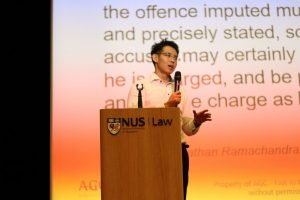
Dy SSC Zhuo then led us into an informative lecture on behalf of the AGC. Other than an introduction to the charge, Mr. Zhuo also talked about the problem of double counting, the principle that one cannot be punished twice for the same act. Following which, he then went through the principle of joinder of accused persons, as an exception to s132(1). whereby each accused had to be charged separately.
Mr. Zhuo then went through the disclosure of information by the Prosecution. Highlighting the changes in the CPC over the years, Mr. Zhuo went on to talk about common law duties of the Prosecution, such as the obligation to disclose both any unused material that is likely to be admissible and might reasonably be regarded as credible and relevant, as well as any unused material which may be inadmissible but would still provide a real chance of pursuing a line of inquiry which is relevant to the guilt of the accused. Lastly, Mr. Zhuo talked about the trial process in detail. Mr. Zhuo went into details regarding expert methodology and the role played by the Defence Counsel in challenging it. Conclusions reached by the expert could then be given much less weight.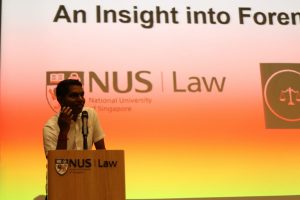
Mr. Kalidass, who both served 10 years as a Public Prosecutor before opening his own firm (Kalidass Law Corporation), closed off the series of mini-lectures, shared with us his unique insights on the intricate workings of the criminal justice system. Mr. Kalidass recounted various tales from his time in practice, such as the unfortunate case of an old lady who ended up in the blind spot of a bus, proven by forensic evidence, or even telephone forensics. A man was charged with trafficking in drugs, who argued that he had intended to eat all of the packets to commit suicide. As fanciful as it sounded, thanks to telephone forensics, his intention to indeed commit suicide was proven by circumstance and text messages, resulting in a reduced charge from trafficking to possession. Forensics, as Mr. Kalidass said, is useful, but it cuts both ways. Closing off the lecture, Mr. Kalidass emphasised the power of forensics to discover the truth.
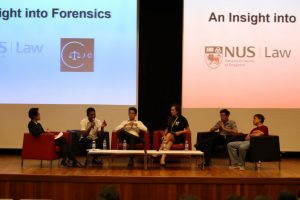
The speakers then segued into a short panel discussion. Speakers dealt with challenging questions such as what to do in cases of fabrication of evidence before moving on to the next event. Bryont briefly went through the trial problem with the crowd, involving a severe head injury and a tale of betrayed love.
STORYLINE & FORENSIC SCIENCE PRACTICAL SESSION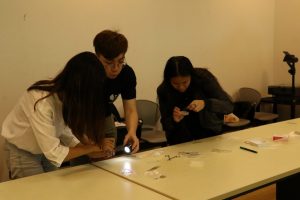
The participants were then introduced to a hypothetical case of murder through a short video and an information sheet. The rest of the event was then structured around the hypothetical, and “solving” the victim’s death.
In the practical session, the participants had a valuable chance to experience hands-on learning of different forensic techniques. At the station for DNA analysis, participants learnt about DNA extraction and amplification (the latter being achieved through a Polymerase Chain Reaction (PCR)). The fingerprint station allowed the participants to lift fingerprints from the alleged murder weapon in the hypothetical – a wine bottle and understand how fingerprints are matched to suspects. Another station introduced blood splatter analysis to participants, and how scientists may identify how weapons were used to injure the victim. The students of NUS FS also introduced the Hexagon OBTI and Kastle-Mayer test for blood testing. Finally, there was also a station which taught students how shoe prints are lifted and molded from clay samples. Shoeprints not only provide forensic scientists with crucial evidence, but the minerals left behind by the perpetrator’s shoes may also provide clues as to where the perpetrator might have been before the commission of the crime.


MOCK TRIAL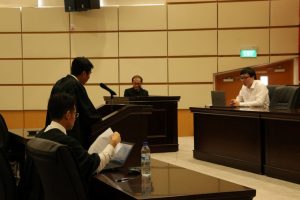
The exciting day was then rounded up with a mock trial. A terrific display of a criminal trial was put on by Dy SSC Zhuo Wenzhao as the prosecutor, Mr Lee Chun Yee as the defence counsel and Prof Lim Lei Theng as the judge.
The participants got to observe the counsels in action, conducting examinations-in-chief and grueling cross-examinations.
Later, the counsels answered questions from the floor, and shared more about sentencing principles.


CONCLUSION

If forensic science has to be summarised in one quote, it would be the quote from A/P Stella’s presentation. A/P Stella included a photo of Dr. Henry, outside the Connecticut Forensic Science Laboratory in Meriden, posing next to a sculpture of a skeleton in a chair. Titled ‘Witness’, the sculpture also came with the following inscription:
“If the law has made you a witness, remain a person of science; you have no victim to avenge, no guilty or innocent person to convict or save. You must bear testimony within the limits of science. Let the evidence speak for itself.”
*The views and opinions expressed in this article do not constitute legal advice and solely belong to the author and do not reflect the opinions and beliefs of the NUS Criminal Justice Club or its affiliates.
